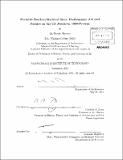| dc.contributor.advisor | Caroline A. Jones. | en_US |
| dc.contributor.author | Sheren, Ila Nicole | en_US |
| dc.contributor.other | Massachusetts Institute of Technology. Dept. of Architecture. | en_US |
| dc.date.accessioned | 2012-01-12T19:25:30Z | |
| dc.date.available | 2012-01-12T19:25:30Z | |
| dc.date.copyright | 2011 | en_US |
| dc.date.issued | 2011 | en_US |
| dc.identifier.uri | http://hdl.handle.net/1721.1/68412 | |
| dc.description | Thesis (Ph. D.)--Massachusetts Institute of Technology, Dept. of Architecture, 2011. | en_US |
| dc.description | Cataloged from PDF version of thesis. | en_US |
| dc.description | Includes bibliographical references (p. 213-232). | en_US |
| dc.description | Artists working on the U.S. side of the U.S.-Mexican border have, since the 1970s Chicano movement, actively explored this charged site in generating socially conscious art projects. This border art, formerly seen as "marginal," is explored in this dissertation as central to an interrogation of site-specificity and globalization - particularly in the medium of performance art. Based on an analysis of artworks from four decades by artists such as David Avalos and the Border Art Workshop/Taller de Arte Fronterizo, Guillermo Gómez-Peña, Coco Fusco, Felipe Ehrenberg, and the collaborative team of Allora and Calzadilla, the dissertation claims that border artists both anticipated and responded to larger economic and social shifts, particularly the trade relations heralded by NAFTA in 1994. Site-specificity and performance became complex and sometimes contradictory tools that these artists used to make statements on the nature of economic and political relations between North and South, rich and poor, American and Mexican, citizen and immigrant. Art, rather than pure political action, is particularly equipped to encourage such exploration, as the indeterminacy of art (rather than the determinacy of political action) allows for the processes of social change. This line of inquiry can be extended to other border and transnational regions. Rethinking art and art history from its "borders" - literal and metaphorical - ultimately destabilizes traditional art historiographic narratives in a productive way. | en_US |
| dc.description.statementofresponsibility | by Ila Nicole Sheren. | en_US |
| dc.format.extent | 232 p. | en_US |
| dc.language.iso | eng | en_US |
| dc.publisher | Massachusetts Institute of Technology | en_US |
| dc.rights | M.I.T. theses are protected by
copyright. They may be viewed from this source for any purpose, but
reproduction or distribution in any format is prohibited without written
permission. See provided URL for inquiries about permission. | en_US |
| dc.rights.uri | http://dspace.mit.edu/handle/1721.1/7582 | en_US |
| dc.subject | Architecture. | en_US |
| dc.title | Portable borders/mythical sites : performance art and politics on the US Frontera, 1968-present | en_US |
| dc.title.alternative | Performance art and politics on the US Frontera, 1968-present | en_US |
| dc.type | Thesis | en_US |
| dc.description.degree | Ph.D. | en_US |
| dc.contributor.department | Massachusetts Institute of Technology. Department of Architecture | |
| dc.identifier.oclc | 768470356 | en_US |
